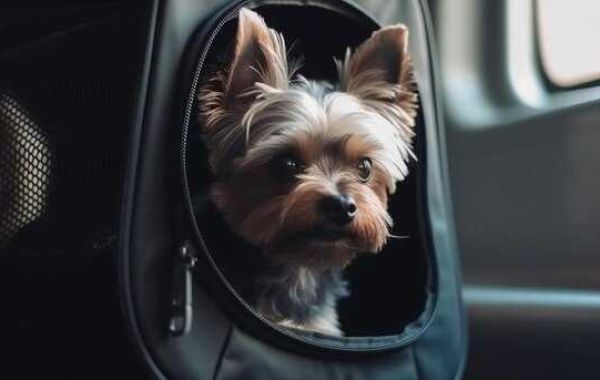
Just like human passengers, pets must enjoy a comfortable, relaxing journey that doesn't upset or scare them. Their safety is essential, so here are some tips to make your life easier when transporting a pet over short or long distances. Ideally, a pet is safely transported in a unique, ventilated pet carrier, always placed on the back seat and secured with a seat belt. In a frontal impact, a medium to large dog will be thrown forward with a force equivalent to that exerted if hit by an object weighing 100 kilograms.
Likewise, placing your pet in the back seat will avoid injury if the airbags deploy, plus the driver will not be distracted from driving. Certain companies have launched a safety belt for dogs, which attaches to the back seat belt, protecting the animal from possible shocks. Keeping the windows closed during the journey is essential, as pets have been jumping out of the car at relatively high speeds. Furthermore, it is crucial not to leave your pet locked in the car once parked, especially on hot days. It is as dangerous for him as it would be for a child.
How Do You Transport Your Pet?
Dogs and cats are much more sensitive to high temperatures and lack of oxygen than humans, so five minutes is enough to endanger their lives. If you are going on a long journey beside the pet carrier, do not forget about breaks and try to feed your pet only when you are stationary and not while walking. When you go on a more extended trip or move to another country, the question may arise: how do you proceed if you have a pet you want to take with you? Fortunately, the answer is more straightforward than you expect.
Most airlines allow the transport of an animal in a pet carrier quickly and safely. You must familiarize yourself with the legal regulations and the transport conditions imposed by the airline company you will fly with. The transport of an animal must be specified from the moment you book your plane ticket. For example, some airlines accept only one cat and one dog on each flight, so additional confirmation of the possibility of transporting the pet is required. However, some low-cost companies do not allow animal transport on board, except those acting as guides for people with disabilities.
What Should You Consider Before Traveling with a Pet?
The laws require the identification by microchipping of all animals that travel outside the country. Also, the animals must be vaccinated against rabies and have a passport issued by an authorized veterinarian. Passengers traveling with a pet must ensure that they have dewormed it. In addition, the animals must have blood samples taken and be treated against tapeworms between 120 hours and 24 hours before travel. For some trips, a health certificate obtained from a veterinarian is required. Each time you travel, check before you make the rules that the airline imposes. Each airline has different regulations for transporting pets if they allow it.
Animals under three months may not be allowed to travel by plane or be subject to special procedures. Most companies allow the free transport of guide animals on most routes. People traveling accompanied by a guide dog must have all the necessary documents for their vehicle, and the company must be informed in advance of the intention to travel with the animal, preferably during the reservation. In general, guide dogs can be transported without a pet carrier, but they must have a leash and a muzzle, even if the latter does not necessarily have to be worn.
Special Cages for Animals

Transport is accepted in the cabin only for small animals (with some airlines), while large animals will be placed in the plane's hold, which benefits from air conditioning. Regardless of the place of storage during the flight, the cage for transport must comply with the regulations of the International Air Transport Association (IATA) and the rules imposed by the airline. If the pet carrier purchased by you does not meet these criteria, the airline company has the right to refuse access to the plane.
Some of the IATA Rules for Pet Carriers:
- The cage must be ventilated on at least three sides, and one must be covered with bars or metal mesh.
- The cage floor must be resistant and not allow leaks, and its surface must be covered with absorbent mats.
- It must be equipped with containers for food and water, which can be filled without opening them.
- The cage must be provided with signs or stickers that warn about the contents (live animals)
- it must have the handles positioned so the airport staff can handle it easily.
- The cage must be removed during check-in if it is equipped with wheels.
Some airlines may refuse to transport dogs of dangerous breeds. Other companies accept these animals in the aircraft's hold, provided that they stay in a safe and bite-resistant cage. To ensure the animal's comfort during the flight, the pet carrier to transport it must allow it to stand up and turn around. Before traveling with an animal from a dangerous breed, please consult the specific regulations of the country where you intend to go. In some countries, for example, it is forbidden to bring certain breeds of dogs.
The pet cannot be left free during the flight, so it must have a pet carrier of appropriate dimensions to move. It is recommended to choose direct, non-stop flights. The animal should not eat or drink water approximately four hours before the trip. If the cage will be transported to the hold, put a blanket because the temperature in the plane's hold is relatively low. Sedation of animals to facilitate transport is a subject of divided opinion. If the animal is generally agitated when traveling, it is best to talk to a veterinarian to determine whether or not sedation is the right solution.







